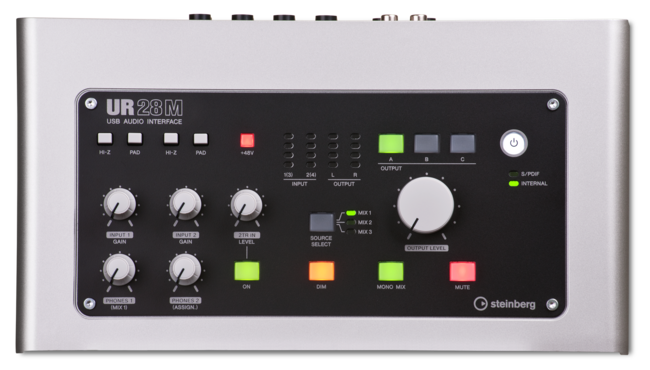
Lets review top-level external USB sound cards Steinberg UR28M and UR824, which have already professional-level big studio features. They have the same : Yamaha D-PRE Class-A microphone preamplifiers, DSP Yamaha SSP2, 24 bits of precision for work with sound, separate monitor headphones outputs with independent volume level control, DAW Cubase AI in the package, fully metallic body and USB 2.0 connection, as previously reviewed sound cards of this family. UR28M is different in : support of 96 kHz sampling rate instead of 192 ( which are not always necessary, for example, human is not able to differentiate signals, which are recorded with 96 kHz and 192 kHz frequencies, but for professional use with subsequent processing high sampling rates are useful ); 2 analogue inputs and 6 analogue outputs; and 1 S/PDIF digital input and 1 the same output.

The top most model UR824 supports : 192 kHz sampling rate; JetPLL synchronization for many devices to stay in sync; 2 digital optical S/PDIF ADAT outputs and 2 the same inputs; and 8 analogue inputs and 8 analogue outputs. Both cards have no MIDI inputs and outputs, so they are more suited for large studio use for analogue signals recording and playback, instead of use with digital instruments. Steinberg UR28M and UR824 have corresponding prices : 499 and 999 USD.
Technical characteristics of microphone/linear inputs of Steinberg UR28M : working sound frequencies range is 20 Hz – 22 kHz ( with +0.1/-0.2 dB deviance ), dynamic range is 101 dB ( A-Weighted ), THD+N 0.002%, channels crosstalk protection is 114 dB, maximal input signal level is +22 dB, impedance is 4 kOhms, gain up to 60 dB and pad down to -26 dB. Instrumental Hi-Z inputs : maximal input signal level is +9.8 dB, impedance is 500 kOhms. Linear inputs 3 and 4 : frequencies range 20 Hz – 22 kHz ( with +0.1/-0.1 dB deviance ), dynamic range is 102 dB ( A-Weighted ), THD+N 0.001%, channels crosstalk protection 110 dB, maximal input signal level 16 dB ( with balanced connection ) and 13.8 dB ( with unbalanced connection ), impedance is 20 kOhms ( balanced ) and 10 kOhms ( unbalanced ). 2TR IN : maximal input signal level is +3.5 dB and impedance is 10 kOhms; maximal power, supplied to headphones outputs, is 35 + 35 mW with 40 Ohms impedance. Linear balanced outputs properties are : working frequencies range is 20 Hz – 22 kHz ( with +0.1 dB/-0.2 dB deviance ), dynamic range is 106 dB ( A-Weighted ), THD+N 0.001%, channels crosstalk protection is 129 dB, maximal signal level is +16 dB with impedance 75 Ohms. In addition to 96 kHz audio interface also supports sampling frequencies 44.1, 48 and 88.2 kHz; it draws maximum 8.4 W of energy, its sizes are 59 ( height ) x 164 ( depth ) x 291 ( width ) mm and mass is 1.4 kg.
Steinberg UR824 has higher technical specifications : working frequencies of balanced microphone/linear inputs are in 20 Hz – 22 kHz range ( with +0.1 dB/-0.1 dB deviation ), dynamic range is 105 dB ( A-Weighted ), THD+N 0.0014%, channels cross-talk protection 125 dB, maximal level of input signal is +24 dB, impedance is 4 kOhms, maximal gain and pad are 60 dB and -26 dB, accordingly. Properties of instrumental Hi-Z inputs are : maximal input signal level is +10 dB and impedance is 1 MOhm. Linear outputs ( balanced ) : working frequencies range is 20 Hz – 22 kHz ( with +0.1 dB/-0.1 dB deviation ), dynamic range is 117 dB ( A-Weighted ), THD+N 0.0009%, channels cross-talk protection is 130 dB, maximal signal level is +18 dB and impedance is 75 Ohms. Maximal power, supplied to headphones equals to 75 + 75 mW with 40 Ohms impedance; besides 192 kHz device also supports 44.1, 48, 88.2 and 96 kHz sampling rates. Device draws 38.4 W of energy, its sizes are 480 ( width ) x 44 ( height ) x 275 ( depth ) mm and mass is 3.1 kg.
Devices work in Windows 7, 8, 8.1 and 10 and Mac OS X with support of ASIO 2.0, WDM and Core Audio interfaces, through which they interact with modern DAWs : Avid Pro Tools, Ableton Live, Steinberg Cubase, FL Studio, Cackewalk Sonar, REAPER and others. Also Steinberg UR28M and 824 are Class Compliant and can work with Apple iPad 2 and newer via Apple iPad Camera Connection Kit.
For installation of DAW Cubase AI there is need in connection to Internet for downloading of additional data with 500 MB size. Steinberg UR242 supports following DSP effects : Latency-free monitoring with FX ( dspMixFx ), True Integrated Monitoring with FX in Cubase, Guitar Amp Classics, REV-X Reverb, Sweet Spot Morphing Channel Strip, Phase switch per channel and High-Pass filter. Cubase AI – is a simplified version of professional DAW of Steinberg, it is based on the same audio engine with 32-bits float precision of calculations; can work simultaneously with 32 sound tracks, 48 MIDI tracks and 16 instrumental tracks with ability to record completed compositions to disk in WAV and AIFF formats, and in MP3 after purchsing of according module. For audio and MIDI editing in program following editors are built-in : Key, Score and Drum, pitch-shift instrument AudioWarp with support of ACID files format, which allows to use large amount of already created sounds samples, and Chord Track editor. 28 VST effects and processors are built into it for work with sounds, sampling synthesizer instrument HALion Sonic SE with 180 sound; mixing console with 4 Inserts and 4 Sends for each track and equalizer. DAW Cubase AI can work in 32 and 64 bits operating systems Windows and Mac OS X.
Package contains : Steinberg UR28M or 824 audio interfaces themselves, optical disks with drivers and programs, power supply unit, warranty card and user’s guide. On disks besides DAW Cubase AI there are : Yamaha Steinberg USB Driver, device control panel, UR28M/824 Extension ( for integration with DAW Cubase ), dspMixFx UR28M/824 ( for integration with other DAWs ), VST plugin Sweet Spot Morphing Channel Strip ( compressor and equalizer ) and VST plugin REV-X – reverberation. Interfaces are very functional and have great digital and analogue parts and large amount of connectors, they are oriented on professional work in large studios and on concerts, their prices are according. There is also ability to look on other audio interfaces of Steinberg, Behringer, Focusrite, Roland, ESI, M-Audio, Alesis and other companies production : among them there can be devices, that are more applicable to specific tasks and that have more acceptable prices for them.
Steinberg – is a German company – creator of DAWs, VST effects, processors and instruments and also of audio interfaces, being based in Hamburg. It was established in 1984 year and now is being owned by Yamaha Corporation from 2004 year. At current moment Steinberg is one of the leading audio equipment and programs manufacturers in the world, for example, its professional DAW, instruments and hardware are used by following musicians : Hans Zimmer, Junkie XL, Justice, Kraftwerk, New Order and others.



